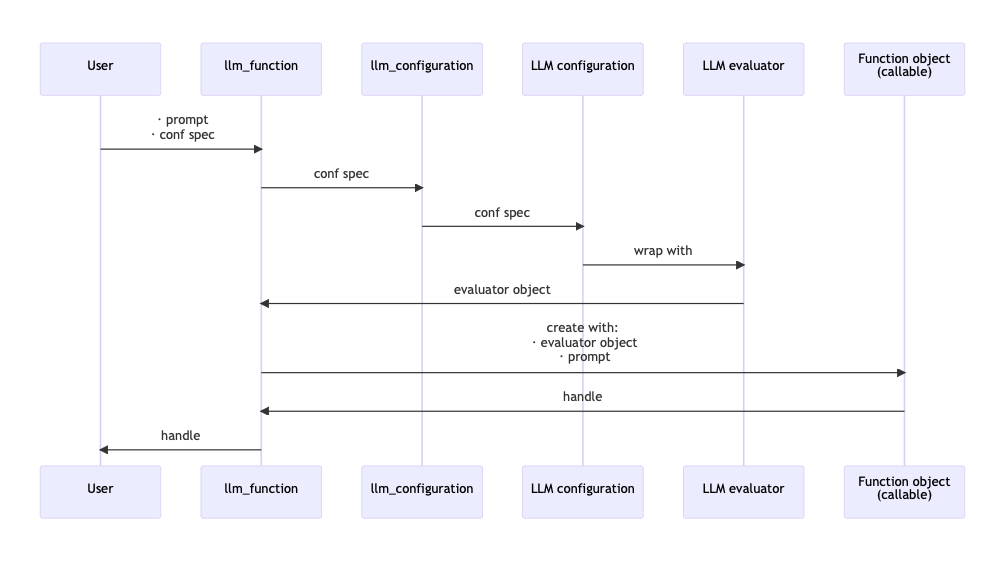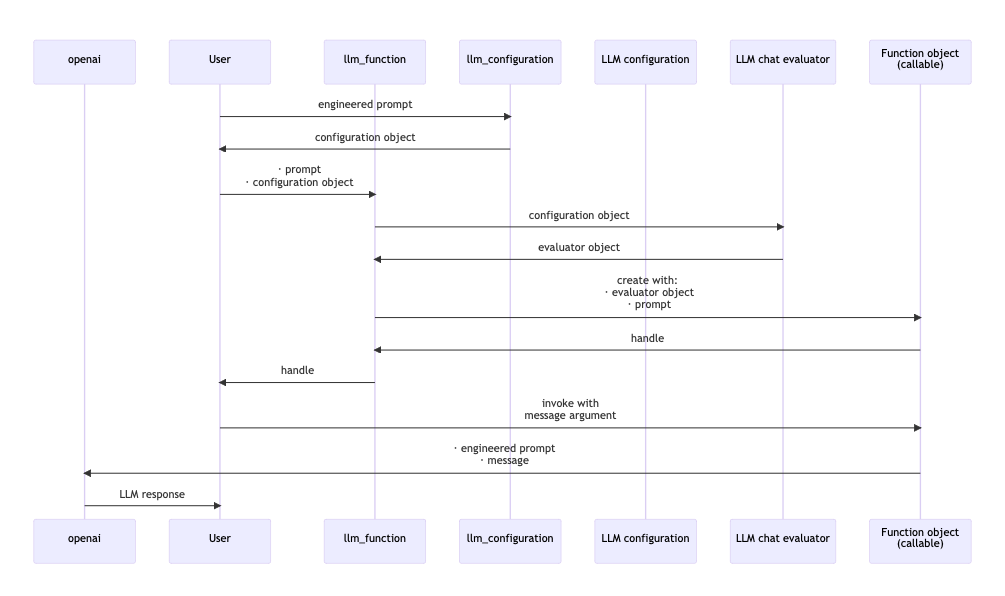This blog post proclaims and describes the Python package “LLMFunctionObjects” that provides functions and function objects to access, interact, and utilize Large Language Models (LLMs), like OpenAI, [OAI1], and PaLM, [ZG1].
The structure and implementation of the Python package closely follows the design and implementation of the Raku package “LLM::Functions”, [AAp1], supported by “Text::SubParsers”, [AAp4].
(Here is a link to the corresponding notebook.)
Installation
Install from GitHub
pip install -e git+https://github.com/antononcube/Python-packages.git#egg=LLMFunctionObjects-antononcube\&subdirectory=LLMFunctionObjects
From PyPi
pip install LLMFunctionObjects
Design
“Out of the box” “LLMFunctionObjects” uses “openai”, [OAIp1], and “google-generativeai”, [GAIp1]. Other LLM access packages can be utilized via appropriate LLM configurations.
Configurations:
- Are instances of the class
LLMFunctionObjects.Configuration - Are used by instances of the class
LLMFunctionObjects.Evaluator - Can be converted to dictionary objects (i.e. have a
to_dictmethod)
New LLM functions are constructed with the function llm_function.
The function llm_function:
- Produces objects that are set to be “callable” (i.e. function objects or functors)
- Has the option “llm_evaluator” that takes evaluators, configurations, or string shorthands as values
- Returns anonymous functions (that access LLMs via evaluators/configurations.)
- Gives result functions that can be applied to different types of arguments depending on the first argument
- Can take a (sub-)parser argument for post-processing of LLM results
- Takes as a first argument a prompt that can be a:
- String
- Function with positional arguments
- Function with named arguments
Here is a sequence diagram that follows the steps of a typical creation procedure of LLM configuration- and evaluator objects, and the corresponding LLM-function that utilizes them:

Here is a sequence diagram for making a LLM configuration with a global (engineered) prompt, and using that configuration to generate a chat message response:

Configurations
OpenAI-based
Here is the default, OpenAI-based configuration:
from LLMFunctionObjects import * for k, v in llm_configuration('OpenAI').to_dict().items(): print(f"{k} : {repr(v)}")
name : 'openai'
api_key : None
api_user_id : 'user'
module : 'openai'
model : 'gpt-3.5-turbo-instruct'
function : <bound method Completion.create of <class 'openai.api_resources.completion.Completion'>>
temperature : 0.2
total_probability_cutoff : 0.03
max_tokens : 300
fmt : 'values'
prompts : []
prompt_delimiter : ' '
stop_tokens : None
tools : []
tool_prompt : ''
tool_request_parser : None
tool_response_insertion_function : None
argument_renames : {}
evaluator : None
known_params : ['api_key', 'model', 'prompt', 'suffix', 'max_tokens', 'temperature', 'top_p', 'n', 'stream', 'logprobs', 'stop', 'presence_penalty', 'frequency_penalty', 'best_of', 'logit_bias', 'user']
response_object_attribute : None
response_value_keys : ['choices', 0, 'text']
llm_evaluator : <class 'LLMFunctionObjects.Evaluator.Evaluator'>
Here is the ChatGPT-based configuration:
for k, v in llm_configuration('ChatGPT').to_dict().items(): print(f"{k} : {repr(v)}")
name : 'chatgpt'
api_key : None
api_user_id : 'user'
module : 'openai'
model : 'gpt-3.5-turbo-0613'
function : <bound method ChatCompletion.create of <class 'openai.api_resources.chat_completion.ChatCompletion'>>
temperature : 0.2
total_probability_cutoff : 0.03
max_tokens : 300
fmt : 'values'
prompts : []
prompt_delimiter : ' '
stop_tokens : None
tools : []
tool_prompt : ''
tool_request_parser : None
tool_response_insertion_function : None
argument_renames : {}
evaluator : None
known_params : ['api_key', 'model', 'messages', 'functions', 'function_call', 'temperature', 'top_p', 'n', 'stream', 'logprobs', 'stop', 'presence_penalty', 'frequency_penalty', 'logit_bias', 'user']
response_object_attribute : None
response_value_keys : ['choices', 0, 'message', 'content']
llm_evaluator : <class 'LLMFunctionObjects.EvaluatorChatGPT.EvaluatorChatGPT'>
Remark: llm_configuration(None) is equivalent to llm_configuration('OpenAI').
Remark: Both the “OpenAI” and “ChatGPT” configuration use functions of the package “openai”, [OAIp1]. The “OpenAI” configuration is for text-completions; the “ChatGPT” configuration is for chat-completions.
PaLM-based
Here is the default PaLM configuration:
for k, v in llm_configuration('PaLM').to_dict().items(): print(f"{k} : {repr(v)}")
name : 'palm'
api_key : None
api_user_id : 'user'
module : 'google.generativeai'
model : 'models/text-bison-001'
function : <function generate_text at 0x10a04b6d0>
temperature : 0.2
total_probability_cutoff : 0.03
max_tokens : 300
fmt : 'values'
prompts : []
prompt_delimiter : ' '
stop_tokens : None
tools : []
tool_prompt : ''
tool_request_parser : None
tool_response_insertion_function : None
argument_renames : {}
evaluator : None
known_params : ['model', 'prompt', 'temperature', 'candidate_count', 'max_output_tokens', 'top_p', 'top_k', 'safety_settings', 'stop_sequences', 'client']
response_object_attribute : 'result'
response_value_keys : []
llm_evaluator : <class 'LLMFunctionObjects.Evaluator.Evaluator'>
Basic usage of LLM functions
Textual prompts
Here we make a LLM function with a simple (short, textual) prompt:
func = llm_function('Show a recipe for:')
Here we evaluate over a message:
print(func('greek salad'))
Greek Salad Recipe:
Ingredients:
- 1 large cucumber, diced
- 2 large tomatoes, diced
- 1 red onion, thinly sliced
- 1 green bell pepper, diced
- 1/2 cup Kalamata olives, pitted and halved
- 1/2 cup crumbled feta cheese
- 1/4 cup extra virgin olive oil
- 2 tablespoons red wine vinegar
- 1 teaspoon dried oregano
- Salt and pepper to taste
Instructions:
1. In a large bowl, combine the diced cucumber, tomatoes, red onion, bell pepper, and Kalamata olives.
2. In a small bowl, whisk together the olive oil, red wine vinegar, dried oregano, and salt and pepper.
3. Pour the dressing over the vegetables and toss to combine.
4. Sprinkle the crumbled feta cheese over the top of the salad.
5. Serve immediately or refrigerate until ready to serve.
Optional: You can also add some chopped fresh herbs, such as parsley or dill, for extra flavor and freshness. Enjoy your delicious and refreshing Greek salad!
Positional arguments
Here we make a LLM function with a function-prompt and numeric interpreter of the result:
func2 = llm_function( lambda a, b: f"How many {a} can fit inside one {b}?", form=float, llm_evaluator='palm')
Here were we apply the function:
res2 = func2("tennis balls", "toyota corolla 2010") res2
350.0
Here we show that we got a number:
type(res2)
float
Named arguments
Here the first argument is a template with two named arguments:
func3 = llm_function(lambda dish, cuisine: f"Give a recipe for {dish} in the {cuisine} cuisine.", llm_evaluator='palm')
Here is an invocation:
print(func3(dish='salad', cuisine='Russian', max_tokens=300))
**Ingredients:**
* 1 head of cabbage, shredded
* 1 carrot, grated
* 1/2 cup of peas, cooked
* 1/2 cup of chopped walnuts
* 1/2 cup of mayonnaise
* 1/4 cup of sour cream
* Salt and pepper to taste
**Instructions:**
1. In a large bowl, combine the cabbage, carrots, and peas.
2. In a small bowl, whisk together the mayonnaise, sour cream, salt, and pepper.
3. Pour the dressing over the salad and toss to coat.
4. Serve immediately or chill for later.
**Tips:**
* For a more flavorful salad, add some chopped fresh herbs, such as dill or parsley.
* You can also add some chopped red onion or celery to the salad.
* If you don't have any peas on hand, you can use green beans or corn instead.
* The dressing can be made ahead of time and stored in the refrigerator. Just be sure to bring it to room temperature before using it to dress the salad.
LLM example functions
The function llm_example_function can be given a training set of examples in order to generating results according to the “laws” implied by that training set.
Here a LLM is asked to produce a generalization:
llm_example_function({'finger': 'hand', 'hand': 'arm'})('foot')
' leg'
Here is an array of training pairs is used:
llm_example_function({"Einstein": "14 March 1879", "Pauli": "April 25, 1900"})('Oppenheimer')
' April 22, 1904'
Here is defined a LLM function for translating WL associations into Python dictionaries:
fea = llm_example_function(('<| A->3, 4->K1 |>', '{ A:3, 4:K1 }')) print(fea('<| 23->3, G->33, T -> R5|>'))
{ 23:3, G:33, T:R5 }
The function llm_example_function takes as a first argument:
- Single
tupleobject of two scalars - A
dict - A
listobject of pairs (tupleobjects)
Remark: The function llm_example_function is implemented with llm_function and suitable prompt.
Here is an example of using hints:
fec = llm_example_function( {"crocodile" : "grasshopper", "fox" : "cardinal"}, hint = 'animal colors') print(fec('raccoon'))
cardinal
Synthesizing responses
Here is an example of prompt synthesis with the function llm_synthesize using prompts from the package “LLMPrompts”, [AAp8]:
from LLMPrompts import * print( llm_synthesize([ llm_prompt("Yoda"), "Hi! How old are you?", llm_prompt("HaikuStyled") ]))
Young or old, matters not
Age is just a number, hmm
The Force is with me.
Using chat-global prompts
The configuration objects can be given prompts that influence the LLM responses “globally” throughout the whole chat. (See the second sequence diagram above.)
Chat objects
Here we create chat object that uses OpenAI’s ChatGPT:
prompt = "You are a gem expert and you give concise answers." chat = llm_chat(prompt = prompt, chat_id = 'gem-expert-talk', conf = 'ChatGPT')
chat.eval('What is the most transparent gem?')
'The most transparent gem is diamond.'
chat.eval('Ok. What are the second and third most transparent gems?')
'The second most transparent gem is sapphire, and the third most transparent gem is emerald.'
Here are the prompt(s) and all messages of the chat object:
chat.print()
Chat ID: gem-expert-talk
------------------------------------------------------------
Prompt:
You are a gem expert and you give concise answers.
------------------------------------------------------------
{'role': 'user', 'content': 'What is the most transparent gem?', 'timestamp': 1695699574.024279}
------------------------------------------------------------
{'role': 'assistant', 'content': 'The most transparent gem is diamond.', 'timestamp': 1695699575.158463}
------------------------------------------------------------
{'role': 'user', 'content': 'Ok. What are the second and third most transparent gems?', 'timestamp': 1695699588.455979}
------------------------------------------------------------
{'role': 'assistant', 'content': 'The second most transparent gem is sapphire, and the third most transparent gem is emerald.', 'timestamp': 1695699589.6835861}
References
Articles
[AA1] Anton Antonov, “Generating documents via templates and LLMs”, (2023), RakuForPrediction at WordPress.
[ZG1] Zoubin Ghahramani, “Introducing PaLM 2”, (2023), Google Official Blog on AI.
Repositories, sites
[OAI1] OpenAI Platform, OpenAI platform.
[WRIr1] Wolfram Research, Inc. Wolfram Prompt Repository.
Packages, paclets
[AAp1] Anton Antonov, LLM::Functions Raku package, (2023), GitHub/antononcube.
[AAp2] Anton Antonov, WWW::OpenAI Raku package, (2023), GitHub/antononcube.
[AAp3] Anton Antonov, WWW::PaLM Raku package, (2023), GitHub/antononcube.
[AAp4] Anton Antonov, Text::SubParsers Raku package, (2023), GitHub/antononcube.
[AAp5] Anton Antonov, Text::CodeProcessing Raku package, (2021), GitHub/antononcube.
[AAp6] Anton Antonov, ML::FindTextualAnswer Raku package, (2023), GitHub/antononcube.
[AAp7] Anton Antonov, ML::NLPTemplateEngine Raku package, (2023), GitHub/antononcube.
[AAp8] Anton Antonov, LLMPrompts Python package, (2023), PyPI.org/antononcube.
[GAIp1] Google AI, google-generativeai (Google Generative AI Python Client), (2023), PyPI.org/google-ai.
[OAIp1] OpenAI, openai (OpenAI Python Library), (2020-2023), PyPI.org.
[WRIp1] Wolfram Research, Inc. LLMFunctions paclet, (2023), Wolfram Language Paclet Repository.